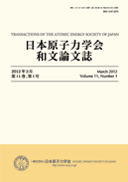Volume 3, Issue 2
Displaying 1-9 of 9 articles from this issue
- |<
- <
- 1
- >
- >|
-
2004 Volume 3 Issue 2 Pages 141-150
Published: June 25, 2004
Released on J-STAGE: March 08, 2010
Download PDF (8671K) -
2004 Volume 3 Issue 2 Pages 151-164
Published: June 25, 2004
Released on J-STAGE: January 21, 2010
Download PDF (26288K) -
2004 Volume 3 Issue 2 Pages 165-173
Published: June 25, 2004
Released on J-STAGE: March 08, 2010
Download PDF (12670K) -
2004 Volume 3 Issue 2 Pages 174-184
Published: June 25, 2004
Released on J-STAGE: January 21, 2010
Download PDF (19514K) -
2004 Volume 3 Issue 2 Pages 185-192
Published: June 25, 2004
Released on J-STAGE: March 08, 2010
Download PDF (8939K) -
2004 Volume 3 Issue 2 Pages 193-199
Published: June 25, 2004
Released on J-STAGE: March 08, 2010
Download PDF (11825K) -
2004 Volume 3 Issue 2 Pages 200-207
Published: June 25, 2004
Released on J-STAGE: March 08, 2010
Download PDF (3682K) -
2004 Volume 3 Issue 2 Pages 208-214
Published: June 25, 2004
Released on J-STAGE: March 08, 2010
Download PDF (12581K) -
2004 Volume 3 Issue 2 Pages 215-232
Published: June 25, 2004
Released on J-STAGE: January 21, 2010
Download PDF (1421K)
- |<
- <
- 1
- >
- >|
